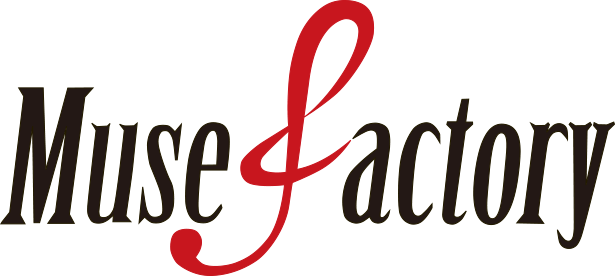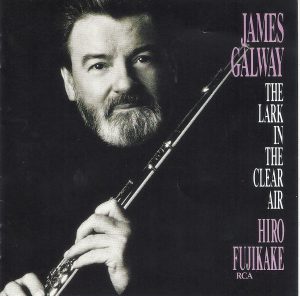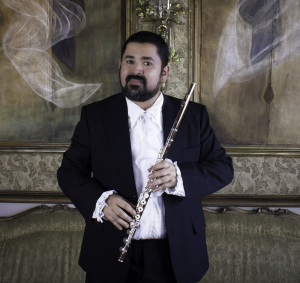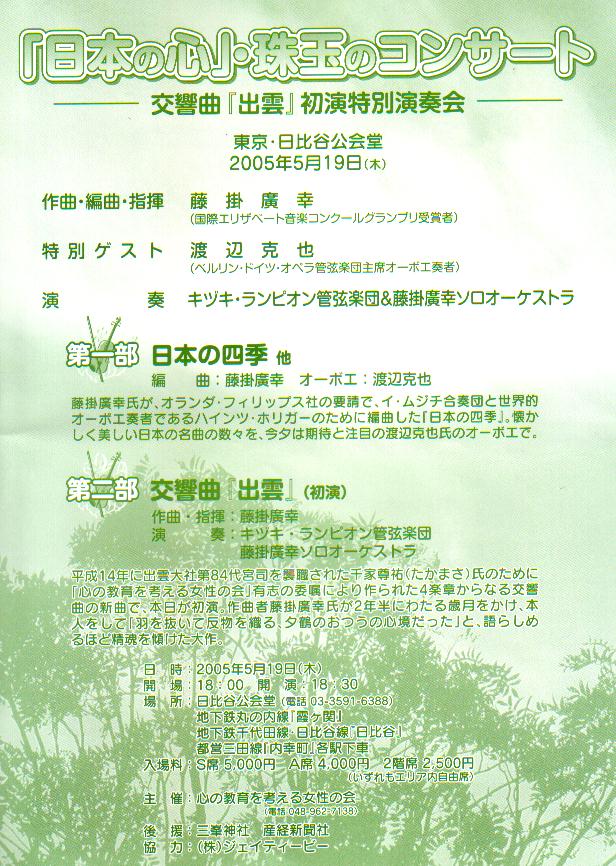Sir James Galway
Contents
Hiro Fujikake encountered Sir James Galway in 1988
It was 1988 when Hiro Fujikake first met Sir James Galway. When Hiro was living in London, he approached RCA Records to produce his symphonic works. Ralph MACE who was working for the company as a music producer introduced Hiro to James Galway. Instinctively Ralph felt they could be the perfect match for new release and he was right.

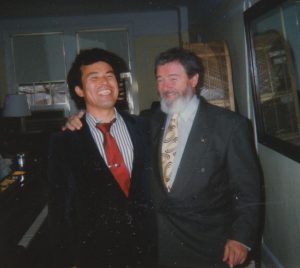
Letter from Ralph Mace (music producer for the CDs of James Galways and Hiro Fujikake)
Hiro Fujikake and Ralph had friendship almost 30 years.
Dear Hiro Fujikake
I first met Hiro Fujikake in 1985 when I was director of classical music for RCA Records in London. This was shortly after he had won the composition prize at the prestigious Queen of the Belgian’s Music Competition and he came to my office to see if we would be interested in recording some of his serious music works. I explained to him that there was very little interest for contemporary music recordings at that time and asked what else he might have. So he played me a cassette of some of his light music pieces which he had recorded on his electric keyboards. The very first of these was The Enchanted Forest and after just a few bars my eyes lit up and I knew that I had found something very important.
Several years before, I had signed the wonderful flutist, James Galway, to RCA Records. The records we had made included several “cross over” albums, including “Annies Song” which was very successful and reached the tops of the pop charts in Europe and North America. We then recorded a few similar albums including “Songs of the Sea Shore – a collection of Japanese folk songs” which we recorded in Tokyo with a studio orchestra conducted by Maestro Hiroyuki Iwaki. Following these successes, Mr. Galway now had very many “middle of the road” fans all over the world who were still hoping for more similar repertoire from him, but this was becoming difficult to find.
Immediately I knew that these pieces by Hiro were perfect for James Galway. I sent him the cassette, he agreed with me and so we arranged to make a recording of Hiro’s pieces and arrangements during James’ concert tour of Japan in 1988.
We all met together in the Sound Valley Studios in Tokyo on March 13th, 1988. It was a slightly nervous meeting. James and Hiro had not met before and we had never recorded with an accompaniment solely of electronic keyboard instruments – all of which Hiro was to play. We set up the Roland synthesizers, put a pair of headphones on James’ head and played the first track for him. The mood in the studio quickly became warm and confident. James and Hiro worked happily together as two great musicians should, and the results can now be heard on the CD of The Enchanted Forest, which millions of people have enjoyed.
I soon found that Hiro was also a man of great charm and humour. At the end of the first day’s work he asked what I was going to do afterwards. I said that I would take a taxi back to my hotel. “I am going to the station and it is on the way to your hotel, can we share a taxi?” Of course we could. Just before we arrived at the station, Hiro suggested that I should join him for a meal at the station before he caught his train home. That seemed a good idea and we went into one of his favourite “noodle shops”. Everything in the restaurant was in Japanese, not a word in English, so I asked Hiro to order something for me. “Do you like noodles?” has asked. “Why not!” and the noodles soon appeared on the table. All this was quite an exciting and new experience for me, I carefully watched everything that Hiro did so that I could then do likewise. Hiro noticed this and as he filled his spoon with the delicious food he smiled at me and gave me a first lesson in Japanese table etiquette, “In Japan” he said, “it is good manners to make big noise when you eat noodles!” We have got on famously ever since.
The Enchanted Forest was a big success and a sequel was required and so we recorded The Lark In The Clear A ir in Sydney, Australia, in 1992 where James was making a concert tour. This time we used traditional and classical repertoire which included an English folk song (the title track), and then ranged from the Albinoni Adagio, via Borodin (the beautiful Notturno from the String Quartet) and Shostakovich (the Romance from “The Gadfly”) to a most exotic arrangement for solo flute and synthesizers of Debussy’s Prelude a l’apres midi d’un faune. Again the album was a success and fully displays Hiro’s mastery as a performer and at arranging traditional repertoire so that it sounds as if the great composers, if alive today, would automatically have written for the Roland synthesizer’s. The only other musician I know who has a similar unique talent is Hiro’s compatriot, Isao Tomita, who I am also happy to count as one of my colleagues and friends.
For me, Hiro Fujikake has achieved his success in music through his skill as a performer and arranger and particularly for his great gift – something that has to be “God-given”, for it cannot be taught – of being able to create magical melodies which all can enjoy.
“Hiro, it is a privilege to know you.”Ralph Mace August 2004
The Enchanted Forest – Melodies of Japan
This CD was the USA Billboard Top 10 of the Classical crossover section in five months (The best rank was 2) in 1990.
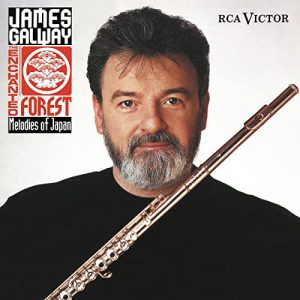

In the introduction to the Japanese edition of “The Man with the Golden Flute,” by Sir James Galway, Galway mentions that “The Enchanted Forest -Melody of Japan” is one of his favorite albums, and every time he listens to the album beautiful memories of Japan come back to his mind.
At the beginning of this project, Hiro Fujikake was just asked to arrange his own original work as well as traditional Japanese folk songs for solo flute and orchestra. As meetings progressed the concept of the project was totally changed. During the selection of music, they thought it would be more innovative and sensational if they used synthesizer rather than a standard orchestra with flute. Although Hiro specialized in symphonic music, they wanted to use Fujikake’s lighter music to bring out the delicate flute melodies. So, the music was selected from Japanese TV music and ballet music composed by Hiro. Music from “ROMANCE,” Hiro’s 2nd solo synthesizer album and some Japanese folk songs were also included. Hiro oversaw all arrangements and synthesizer programming. As the recording proceeded, Jimmy, Ralph and Hiro collaborated spontaneously: “Let’s add sounds of water and hummingbirds!” “Why don’t we add real guitar and bass sounds?” It was exciting for them to work together and it turned into a transformative album in the classical field, ranking in the Billboard Top 10 for five months in a row. The music evokes images of musical fairies bathing in the Enchanted Forest.
The Lark In The Clear Air
I received the sheet music for Prélude à l’apres midi d’un faune from Sir James Galway for the second album, and I found that it would be difficult to make the best use of flute solo with this original. So I suggested moving the melody to a higher key. He was surprised by my suggestion and said, “Are you really going to change the masterpiece of Claude Debussy?” Then I joked that “He wouldn’t care since he is sleeping in the ground,” and continued, “In order to bring out 100% of your charm, it’s better to move it up.” He was suspicious and said, “Keep the same harmony!” I answered, “OK! trust me.” Then I arranged the music.
The recording was made in Sydney, Australia. All the staff were anxious about my arrangement. As soon as the recording was finished, everyone stood up and said “Bravo!!” with a big round of applause.
“Mr. Debussy, please accept my apology. I rearranged your masterpiece 3 times, but I finally got a wonderful outcome. Appreciate your generosity”


Ralph Mace and Hiro at Hiro’s Studio.
